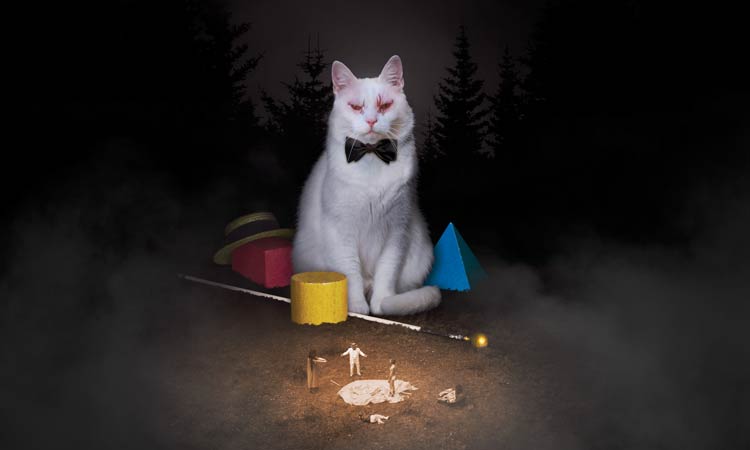Fans of grim but strangely uplifting films but who also happen to love Groundhog Day, will have a new horror fable to prioritise in 2020 with Koko-di Koko-da.
This second feature from Swedish director Johannes Nyholm really does do something inventive – and frequently disturbing – with a time loop storytelling device.
Koko-di Koko-da follows a grieving married couple taking a holiday, stopping off in the woods on the way to camp for the night, only for their tent to come under siege from a group of figures straight out of the circus of your nightmares. We talk to Nyholm about his film…
How would you describe your film?
It’s a drama about a relationship that is breaking apart and it’s inspired by situations like that, where you sometimes feel that the whole world around you is falling apart. A lot of the experiences in the film I actually saw with my own eyes, through my own relationships and others’, as well as in dreams.
The whole film has the structure of a dream. Dreams, or nightmares at least, have this loop structure with small differences where you walk around in eternal loops trying to escape. But the small differences between one loop and another is something I wanted to convey with the structure of the film. And it’s also an interesting way to portray grief.
Do you have any favourite films that also explore grief with a heightened atmosphere?
Don’t Look Now is fantastic and it also has a very dream-like structure. I wasn’t inspired so much by other films but more by my own experiences.
You shot very early in the mornings for much of the production, which gives the second and third acts of this film this hazy, dreamy feeling…
It’s supposed to be like a limbo state; a transition between awake and asleep. There’s no real contrast. Everything is kind of floating, you don’t really know where you are. I wanted to achieve a timeless mood. A lot of the film was shot really, really early in the morning. The hour of the wolf, they call it sometimes. That’s the time of the night when you dream the most, have the most violent dreams. It took a lot effort to pull off because you don’t have so many hours to shoot, no more than one usually, because if we stayed longer that specific level of light would pass. I think we were out in the woods for 20 days.

Where does the title, Koko-di Koko-da, come from?
It comes from a children’s song that’s been sung in many languages, originally a French folk song called ‘Rooster’s Death’ or something like that in English. In French, it’s ‘Le Coq Est Mort’. It’s a childish, naive song about a dead rooster that can’t sing ‘koko-di koko-da’ anymore. You repeat that ‘koko-di koko-da koko-di koko-da’ in the refrain. It’s a song with a lot of morbid undertones. It came in early when writing. I wanted the gentleman in the white costume, who leads the group terrorising the couple in the tent, to sing a song; to have a melody surrounding him. And I thought of that old children’s song, which has a weird structure as well, which fits well with the film. The song has this structure of a never-ending loop that you’re trapped in and can’t escape.
What was behind the concept of the three figures that plague the protagonists throughout the film?
In the discussions with me and the costume designer, it was about making them look like how they came across in my dream. If you like, you can probably see a symbolic meaning to each and every one of them.
Interspersed throughout the film are a few different sequences of shadow puppetry, depicting fables… They weren’t there from the beginning, but I felt the film was too cruel without them. It’s a violent and harsh film and I think it needed a bit of comfort for the viewer; to show some beauty. That’s why I added it, to make people be able to still sleep afterwards.
What kind of reactions have you been getting from audiences?
It’s been very mixed. For some people, it’s a comedy and they laugh a lot at the violence. Others love it and take it very personally. Yet others are engrossed by it and find it disturbing. It doesn’t really look like many other films so that makes it hard to compare it to other things. Some people are prepared only for the usual sorts of entertainment, so for them it can take a lot of effort.
You did a tour of the film on a bus in Sweden. What was that like?
One reason I did that is I wanted to have a private dialogue with the audience, to talk to them afterwards. We wanted to make the framing of the film as personal as the film itself, and wanted to take the film out to people instead of forcing them into a cinema. The bus we used for the tour had been used for this mobile theatre a long time ago, so it had a stage inside to seat 40 to 50 people. And then we redid it into a cinema. It was a really neat way to show the film and have a super intense experience with everyone crammed together in a really small space. A bit claustrophobic and warm, but a very friendly way to show the film and take care of the audience. We talked a lot afterwards and I tried to explain things in more detail than a traditional Q&A.
Koko-di Koko-da will be released exclusively on BFI Player on 7 September and is available on Blu-ray and digital from Picturehouse Entertainment. Read our review here.
